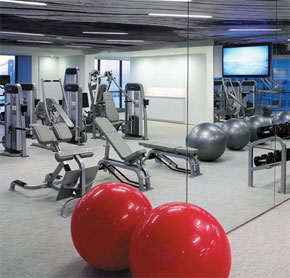
Gym flooring has long been used for indoor basketball courts, and is now gaining traction as a home gym flooring option. Home owners are finding that they enjoy the impact absorption that gym flooring gives them, and they are even finding new and innovative ways to use it throughout their homes.
Why Use Gym Flooring?
High impact aerobics and most sports can cause a lot of stress on your body. The right flooring can absorb a portion of the shock and can help prevent injuries to the athlete. Having an injury is costly, both from a health and financial standpoint. Most find that good gym flooring is well worth the cost.
What Are the Different Types of Gym Flooring?
Rubber – Rubber is one of the most popular choices in gym flooring. It is not only resilient, but also very durable. Rubber can give you traction as you lift weight, and can help keep you from slipping. Rubber flooring comes in both a large roll and interlocking rubber tiles. Rubber tiles are easy to install, which makes them an excellent choice in a home setting.
Foam – Foam provides an excellent cushion. It is an inexpensive product, and usually comes in colorful interlocking tiles. However, it is not nearly as durable as rubber. Shoes with a hard sole or high heal can easily tear holes in them. If your gym is a high traffic area, you probably want to consider a different product. Polyurethane – A seamless polyurethane flooring is somewhat costly choice for gym flooring, but is extremely strong and durable. The installer lays a rubber underlayment and then pours layer upon layer of polyurethane. This process makes the floor a great shock absorber, but it is also very strong and durable. The top layer has color pigment applied, and can have designs such as a mascot or team logo. While this flooring is reasonable when used for a large area, the cost may be prohibitive in a smaller gym or home setting. PVC Tiles – PVC tiles used for gym flooring are both firm and soft. They are very comparable to rubber tiling.
Carpet Tiles – An economical choice, carpet tiles are an option for gym flooring. You may purchase expensive gym padding for placement under the carpet to get a custom amount of shock-absorption. Carpet tiles are easy to install and come in many different colors.
Hardwood Flooring – Often used in basketball courts, hardwood flooring with the proper padding can be a good choice for a gym that has multiple functions. It is usually a more costly option than synthetic flooring such as rubber.
Where Else is Gym Flooring Used?
Flooring that is typically found in gyms, such as rubber floors, has made it’s way into other areas of the home or office. Children’s play areas are a perfect place for gym flooring, as the shock absorption keeps fall injuries at a minimum. Heavy kitchen users appreciate gym flooring, as it keeps stress off of their joints as they stand for long periods of time.
More and more people are choosing gym flooring every day. It is a versatile flooring that meets many needs. Several of the more popular types can be installed by homeowner, which makes incorporating gym flooring into your design plan an easy choice.





